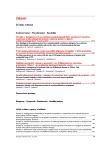The use of natural colloids in fluid resuscitation of severely burned patients
Authors:
L. Fridrichová 1; B. Lipový 1,2; P. Brychta 1,2
Authors‘ workplace:
Lékařská fakulta Masarykovy univerzity Brno
1; Klinika popálenin a rekonstrukční chirurgie FN Brno
2
Published in:
Transfuze Hematol. dnes,18, 2012, No. 4, p. 169-173.
Category:
Comprehensive Reports, Original Papers, Case Reports
Overview
Objective:
The amount of natural colloids (albumin and fresh frozen plasma) administered during fluid resuscitation of burn patients is influenced by many factors. The most frequently cited include extent of the burned areas, presence of inhalation injury and age. The aim of our study was to determine whether these factors actually have such an influence on burn resuscitation, as expected.
Material and Methods:
The study included 75 patients treated at the Department for Burns and Reconstructive Surgery at the University Hospital in Brno from 2005 to 2010. We retrospectively investigated the amount of human albumin (HA) and fresh frozen plasma (FFP) during the 1st-7th and during the 8th and 14th day. Plasma concentrations of 60 g/L for total protein and 30 g/L for human albumin were set as the transfusion trigger values. Statistically, we evaluated whether more colloids, FFP and HA separately, were administered in patients with inhalation trauma, in patients over 50 years and in patients with a greater extent of burns. We then divided the patients into four groups according to the extent of burned areas and assessed the data within each group.
Results:
Extent of the burned areas proved to be statistically highly significant. This manifested especially as a difference between the groups with burns extending up to 50% (in patients up to 10%, 30% and 50% burned areas). The difference between patients with burns extending from 30 to 50%, and patients with burns extending over 50% was not statistically significant. The effect of the presence of inhalation injury was shown to be somewhat controversial. When evaluating its impact regardless of the extent of the burned areas, the difference between the amount administered to patients with inhalation injury and to those without was statistically very significant. However, the same did not apply when it was evaluated in the different groups. Age did not have any effect on the amount of natural colloids administered.
Conclusion:
While the study showed a significant effect of the extent of burned areas on the amount of natural colloids administered during the first 14 days after the burn, the effect of the presence of inhalation trauma remains controversial. The effect of age was not demonstrated.
Key words:
burns, fluid resuscitation, natural colloids, inhalation injury, extent of burned areas
Sources
1. Brychta P. Popáleninový šok. Vybrané kapitoly z akutní medicíny 1993; s. 64-79.
2. Kramet GC, Lund T, Bedlám OK. Pathophysiology of burn shock and burn edema. In: Herndon DN. Total burn care. 1. vyd. W.B. Saunders Company, 1996; 93-102.
3. Warden GD. Fluid resuscitation and early management. In: Herndon DN. Total burn care. 1. vyd. W.B. Saunders Company 1996; 107-115.
4. Fodor I, Fodor A, RamonY, Shoshany O, Rissin Y, Ullman Y. Controversies in fluid resuscitation for burn management: Literature review and our experience. International Journal of the Care of the Injured 2006; 37 : 374–379.
5. Herndon DN. Total Burn Care. Philadelphia: Saunders ELSEVIER 2007; 93-106.
6. Googwin CW, Dorethy J, Lam V, Pruitt B A. Randomized Trial of Efficacy of Crystalloid and Colloid Resuscitation on Hemodynamic Response and Lung Water Following Thermal Injury. Ann Surg 1983; 197 : 520-531.
7. Schierhout G, Roberts I. Fluid resuscitation with colloid or crystalloid solutions in critically ill patients: A systematic review of randomised trials. BMJ 1998; 316 : 691–694.
8. Bolero D, Stella M, Guglielmotti E, Magliacani G. Does inhalation injury really change fluid resuscitation needs? A retrospective analysis. Annals of Burns and Fire Disasters 2000; XIII: 198–211.
9. O’Mara MS, Slater H, Goldfarb IW, Caushaj PF. A prospective, randomized evaluation of intra-abdominal pressures with crystalloid and colloid resuscitation in burn patients. J Trauma 2005; 58 : 1011-1018.
10. Ullmann Y, Kremer R, Ramon Y, Berger J, Ullmann A, Peled IJ. Evaluation of validity of the Haifa formula for fluid resuscitation in burn patients at the Rambam Medical Centre. Annals of Burns and Fire Disasters 2000; XIII: 206-213.
11. Dai NT, Chen TM, Cheby ZY, et al. The comparison of early fluid therapy in extensive flame burns between inhalation and noninhalation injuries. Burns 1998; 24 : 671-675.
12. Cochran A, Morfia ES, Edelman LS, Saffle JR. Burn patient characteristics and outcomes following resuscitation with albumin. Burns 2007; 33 : 25–30.
13. Shirani KZ, Pruitt BA, Mason AD. The influence of inhalation injury and pneumonia on burn mortality. Annals of Surgery 1987; 205 : 82-87.
14. Navar PD, Saffle JR, Warden GD. Effect of inhalation injury on fluid resuscitation requirements after thermal injury. Am J Surg 1985; 150 : 716–720.
15. Darling GE, Keresteci MA, Ibanez D, Pugash RA, Peters WJ, Neligan PC. Pulmonary Complications in Inhalation Injuries with Associated Cutaneous Burn. J Trauma 1996; 40 : 83-89.
16. Cancio LC, Chávez S, Alvarado-Ortega M, et al. Predicting increased fluid requirements during the resuscitation of thermally injured patients. J Trauma 2004; 56 : 404–441.
17. Mehmet H, Ebru AA, Karakavali H. Fluid management in major burn injuries. Indian J Plast Surg 2010; 43 : 29-36.
Labels
Haematology Internal medicine Clinical oncologyArticle was published in
Transfusion and Haematology Today

2012 Issue 4
Most read in this issue
- První zkušenosti jednoho centra s použitím přípravku Octaplas® v léčbě pacientky s vrozenou formou trombotické trombocytopenické purpury
- Zajištění operačních výkonů u pacientů s von Willebrandovou chorobou preparátem Wilate® – první klinické zkušenosti jednoho centra v ČR
- Supportive therapy with megestrol acetate in myeloproliferative neoplasms
- The use of natural colloids in fluid resuscitation of severely burned patients
